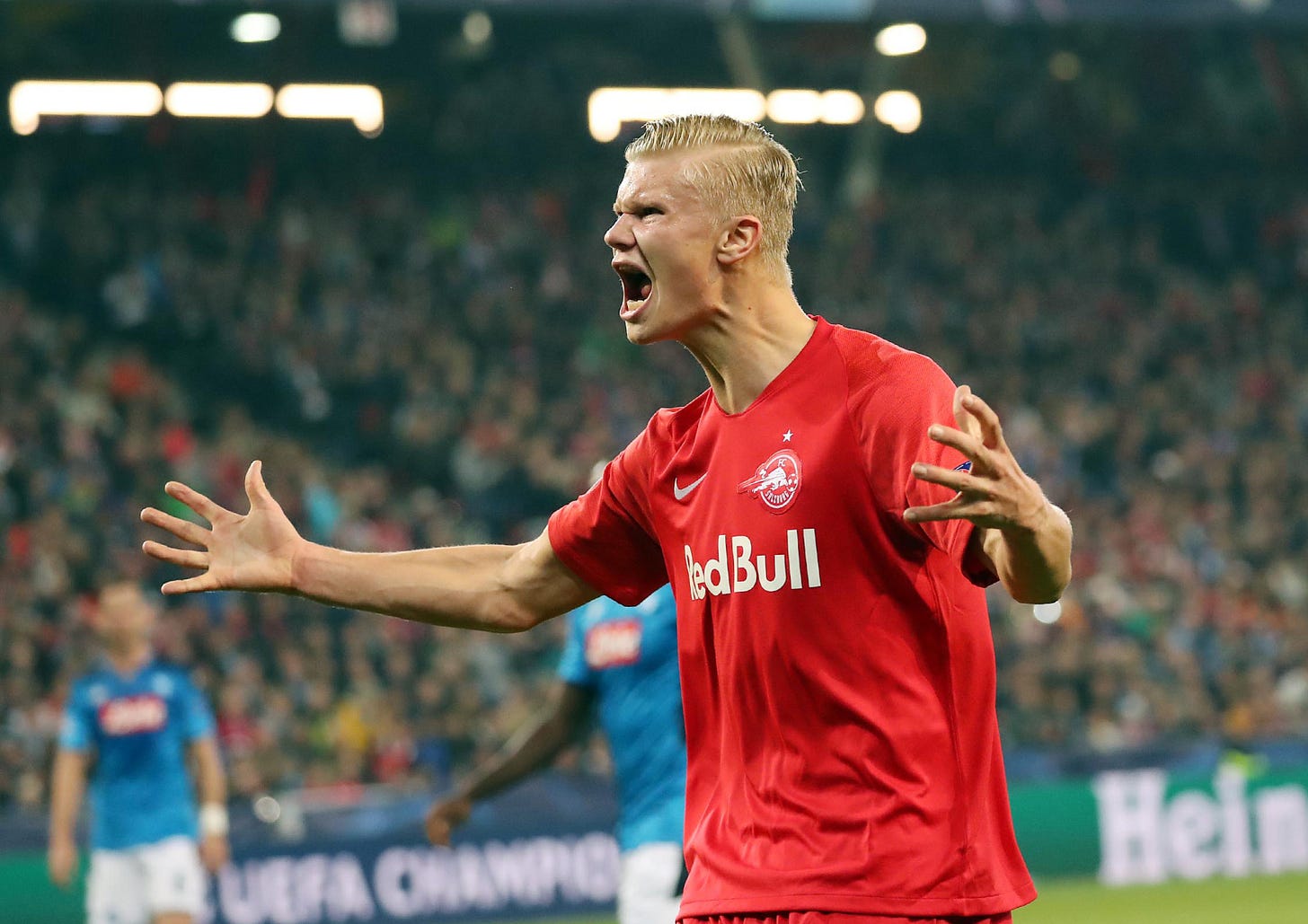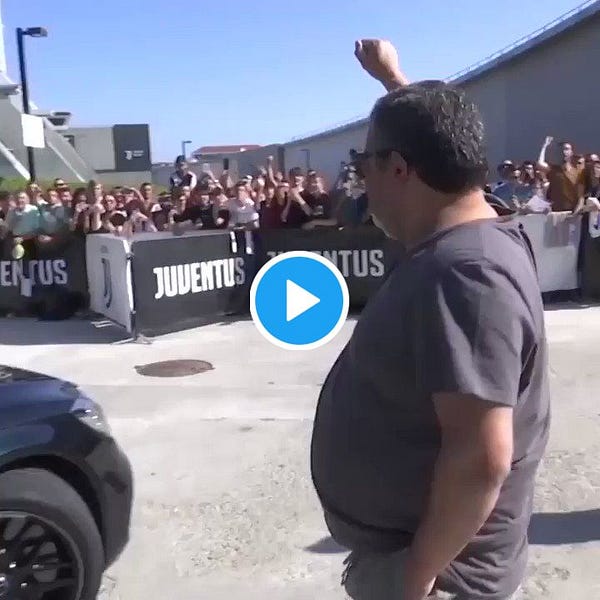How Soccer's Next Superstar Ended Up With Dortmund
Among other things, 2019 was the year we were all introduced to Erling Haaland

Another early one to end the year! I don’t know how many of you will read email on New Year’s Eve, so I’m sending this out on Monday instead of Tuesday. Enjoy the last two days of the decade, all. See you in 2020.
Who had the best 2019? This isn’t a bad place to start: Transfermarkt’s list of the 10 players with the biggest market-value increases over the past calendar year:

A year ago, Joao Felix was just a couple months into his professional career; he’d soon move to Atletico Madrid for the third-highest fee in the history of the sport. Sadio Mane was sitting in the realm of “very good”; earlier this month, he finished fourth in Ballon d’Or voting and earned Lionel Messi’s endorsement. Trent Alexander-Arnold was still in a position where Jurgen Klopp wouldn’t start him in a key Champions League game; he’s now on pace to become one of the best attacking fullbacks of all time. Lautaro Martinez was finding his Serie A sea legs; he’s currently one of the best in the league. Jadon Sancho was lighting up the Bundesliga at what seemed like an unsustainable pace; you can remove that prefix now. Martin Odegaard was dominating the Eredivisie; now he’s dominating La Liga. Federico Valverde was not playing for Real Madrid; he’s since become Zinedine Zidane’s second-era skeleton key. Mason Mount was starting for Derby County; Mason Mount is starting for Chelsea. Raheem Sterling -- well, he’s just continued to be great. And Serge Gnabry blossomed from a nice young player who Arsenal once loaned to West Brom and into a straight-up great player who Arsenal once loaned to West Brom.
Just a couple spots below this list -- in 14th, with a market value the same as Mason Mount and an increase in value the same as Serge Gnabry -- sits Erling Haaland. If you knew who he was on January 1, then you’re probably either a family member, a devoted follower of Norwegian soccer, or a Red Bull Salzburg ultra. He signed a pre-contract with Salzburg in the summer of 2018 to join the Austrian club at the beginning of this year. Last season, he didn’t even reach 90 total minutes for his new club.
Then, this summer at the under-20 World Cup, he did this:
And then, this fall in his first game in the Champions League, he did this:
Sure, they didn’t get out of the group stage, but Salzburg were the story of the Champions League for me -- a stylistic extremity without any fear of failure. Ever wondered what would happen if an NFL team never punted and never ran the ball? What about an NBA team that only shot threes? That’s these dudes:

Haaland finished second behind only Robert Lewandowski, the best striker in the world, in goals scored in the groups (eight). He was second to Lewa in non-penalty goals per 90 minutes (1.44). And he was fourth in non-penalty expected goals per 90 (0.91) -- behind Lewandowski again and the Paris Saint-Germain pair of Kylian Mbappe and Mauro Icardi. Oh, and he’s still a freaking teenager for about seven more months.
Or rather, he won’t be 20 until his second season with Borussia Dortmund. On Sunday, Haaland joined the German club for €22.5 million. Quite the capper on an incredible year, and it raises a couple questions.
First, how will he translate to the Bundesliga? In Austria, Haaland was a stunning brute-force of nature -- with 14 goals and 11 assists in just 985 league minutes. However, the average Elo rating of teams in the Austrian league is just ninth-highest in Europe, right behind England’s second tier. Except, Haaland was actually slightly more productive in the more difficult Champions League -- per 90 minutes, his non-penalty goal rate was a slight tick down (1.37) in domestic play. While he feasted on Genk (four goals), he also scored four goals in four matches against Liverpool and Napoli. Now, six games isn’t much of anything to draw conclusions from, but if you add it to his domestic production, it at least eases any concerns that he might be some kind of, I don’t know, low-tier European bully.
Second, how the hell did he end up at the fourth-place club in Germany for just €22.5 million? Supposedly just about every big club in Europe was looking at him, including Juventus, and his agent is the guy whose name was chanted by Juventus fans over the summer as if he were some infallible club hero who scored the winner in the Champions League final:
To my eyes, Haaland is a better, more proven prospect than Joao Felix in just about every way, and yet Felix went for SIX TIMES THE PRICE. It turns out the fee was so comparatively small -- paying more than 20 million to acquire the labor of an employee whose salary you then have to pay is an absurdity of the modern soccer economy -- because there was a release clause in his contract. It was negotiated into his deal, and according to a source who works with high-level European clubs, he wouldn’t have went to Salzburg without it. Typically, though, other clubs only know about the clause if the player’s agent makes them aware.
So, with a low-ish release clause, Haaland can essentially pick whatever club he wants, so long as that club has the means to meet his fee. Up to this point, his career seems to have been pretty carefully managed. He stayed in Norway as a teenager, joining Molde (and then-manager Ole Gunnar Solskjaer) in 2017, rather than going abroad. Then, he went to the Salzburg prospect-polishing machine rather than joining a top club right off the bat. And now he goes to one of the few clubs that’s capable of 1) paying big wages, 2) providing near-guaranteed playing time to a teenager, and 3) competing at the top of a top European league and in the latter stages of the Champions League. I find it strange that he didn’t just go to the flagship Red Bull club in Leipzig -- his coach seemingly tried to grease the tracks for that one -- but so much player movement in Europe is a shell game. The incentives are rarely strictly competitive, and the finances are purposefully opaque. Fun stuff.
The move to Dortmund benefits Mino Raiola in a number of ways, the same source suggested. As the Guardian reported, Raiola got a €10 million fee as part of the deal. (I mean, what the hell is that?) He and Haaland’s father will also get a cut of the future transfer fee. Supposedly, Manchester United offered a more lucrative contract than Dortmund, but they didn’t want to share the future fees with agent and dad. United are one of the three richest clubs in the world, so it’s pretty hard to imagine a future world in which they’d be in a position to sell him for a profit. If he’s so good that other big clubs want him, that means United will also probably be a lot better than they are now and not in a position to sell! What makes more sense, though, is this: By moving Haaland to a not-quite-uber-rich team, Raiola gets his 10 million, and he’ll likely get another huge cut whenever Dortmund sell Haaland for a huge fee in the future. Had he just moved to United (or Juventus or elsewhere), then that step disappears. The move makes sense for player and agent.
And club, too. Haaland links up with Dortmund’s horde of young talent, and he gives the club that potential for a team-wide leap, where a group of young players all improve at the same time. But he probably won’t have a huge effect on Dortmund’s fortunes this season; the move didn’t shift the betting markets at all, and according to Omar Chaudhuri, head of football intelligence at the consultancy 21st Club, the marginal impact of a single player over half-a-season is rarely more than two points. Dortmund are seven points back of first-place Leipzig.
Longterm, though, Haaland has the potential to, well, be the most impactful player alive. A new duopoly atop the sport is certainly in play. The Norwegian teen is the best attacking prospect since Mbappe -- insanely productive at the professional level at an incredibly young age. Back in September, Mike Goodman ran a similarity search for Haaland using a collection of StatsBomb’s metrics. Two of the results were Mbappe’s previous pair of seasons. The third guy? Mohamed Salah in his first year with Liverpool -- or, you know, the one when he had more goals+assists than anyone else in the history of the Premier League.




